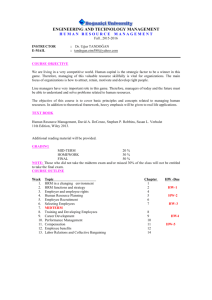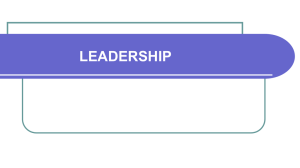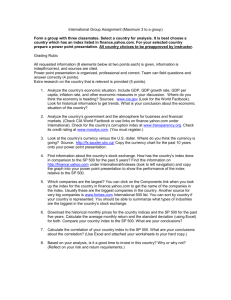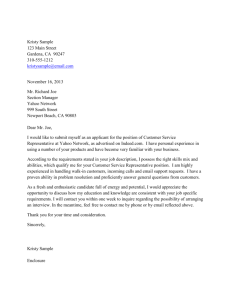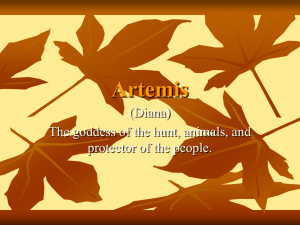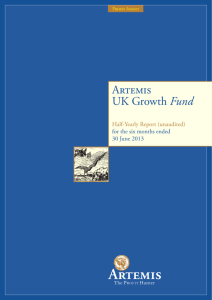Case Study Analysis Questions - School of Informatics
advertisement
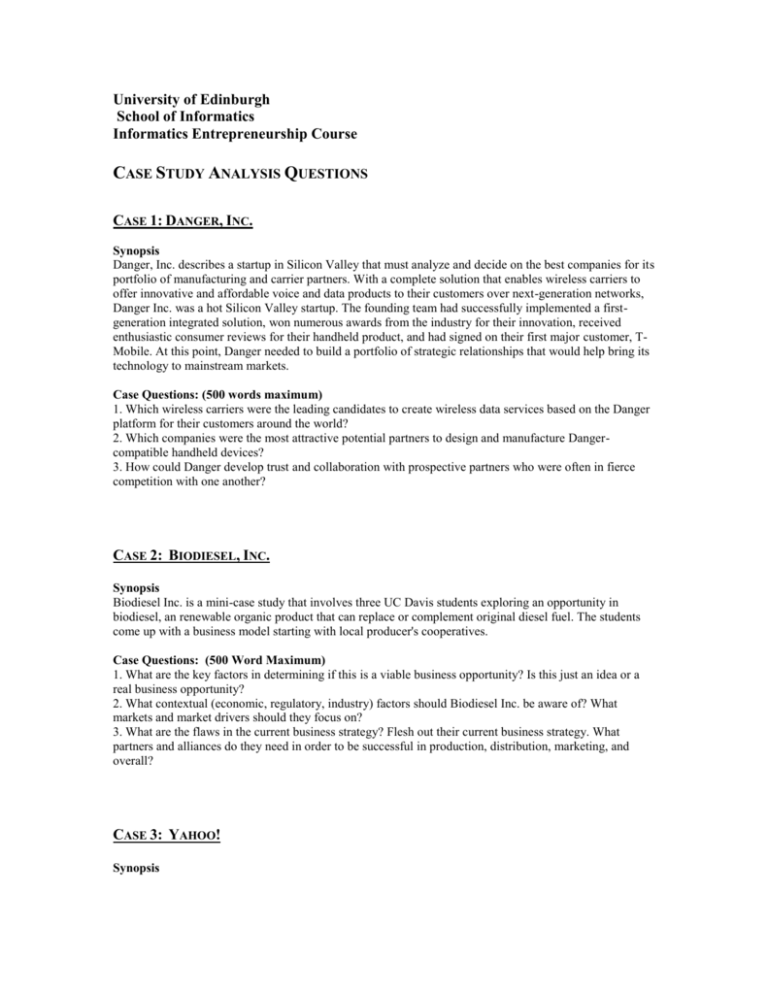
University of Edinburgh School of Informatics Informatics Entrepreneurship Course CASE STUDY ANALYSIS QUESTIONS CASE 1: DANGER, INC. Synopsis Danger, Inc. describes a startup in Silicon Valley that must analyze and decide on the best companies for its portfolio of manufacturing and carrier partners. With a complete solution that enables wireless carriers to offer innovative and affordable voice and data products to their customers over next-generation networks, Danger Inc. was a hot Silicon Valley startup. The founding team had successfully implemented a firstgeneration integrated solution, won numerous awards from the industry for their innovation, received enthusiastic consumer reviews for their handheld product, and had signed on their first major customer, TMobile. At this point, Danger needed to build a portfolio of strategic relationships that would help bring its technology to mainstream markets. Case Questions: (500 words maximum) 1. Which wireless carriers were the leading candidates to create wireless data services based on the Danger platform for their customers around the world? 2. Which companies were the most attractive potential partners to design and manufacture Dangercompatible handheld devices? 3. How could Danger develop trust and collaboration with prospective partners who were often in fierce competition with one another? CASE 2: BIODIESEL, INC. Synopsis Biodiesel Inc. is a mini-case study that involves three UC Davis students exploring an opportunity in biodiesel, an renewable organic product that can replace or complement original diesel fuel. The students come up with a business model starting with local producer's cooperatives. Case Questions: (500 Word Maximum) 1. What are the key factors in determining if this is a viable business opportunity? Is this just an idea or a real business opportunity? 2. What contextual (economic, regulatory, industry) factors should Biodiesel Inc. be aware of? What markets and market drivers should they focus on? 3. What are the flaws in the current business strategy? Flesh out their current business strategy. What partners and alliances do they need in order to be successful in production, distribution, marketing, and overall? CASE 3: YAHOO! Synopsis This case examines the challenges that Yahoo! founders Jerry Yang and David Filo faced in analysing and choosing a first-round financing option. With the possibility of either selling Yahoo! outright, partnering with a corporate sponsor or starting an independent business, Jerry and Dave have to consider not only the established culture and needs of their novel fledging webportal, but their own personal entrepreneurial goals and vision for Yahoo!. The pressure is also on them to make a critical decision, as Mike Moritz of Sequoia Capital offers them deal with a 24 hour deadline. This case also includes excerpts from the original Yahoo! business plan. Case Questions: (500 Word Maximum) 1. What makes Yahoo! a true business opportunity and not just an idea? How do Dave and Jerry's personal goals and vision for Yahoo! align with each of their financing options? What is the vision and the value of Yahoo!? What is its business model and strategy? 2. Analyze the Yahoo! business plan using Sahlman's model as presented in Figure 8.7 (p. 191). Identify the major risks in each of these categories: deal, resources, people, and opportunity. 3. What are the advantages and disadvantages of each of the funding options Yahoo! could pursue? Case 4: Global Wireless Ventures Synopsis Global Wireless Ventures examines the issue of entrepreneurial context. Entrepreneurs must judiciously choose the best enviroment for a home base to support their new venture, weighing not only the location's unique assets, liabilities and risks, but also their own personal needs. This case also provides a good overview of the global wireless industry and industrial clusters that support its growth. Please see this document for corrections to Global Wireless Ventures diagrams in Dorf/Byers 1st Edition. http://edcorner.stanford.edu/techventures/book/Tech_Ventures_Case_Errata.pdf QUESTIONS: (500 WORD MAXIMUM) 1.What is GWV's target customer and target market?2. What factors should GWV consider in comparing the entrepreneurial context in Singapore, Sweden and Silicon Valley? 3. Research Kista, Sweden and Singapore. Based on this research, what are the assets, liabilities and risks in the context of each region? 4. What assets (besides smart money) do you think are most critical for a start-up like Global Wireless Ventures? What institutions are likely to help you access those assets in each region? 5. Which region has the best context for GVW? Why? CASE 5: JON HIRSCHTICK'S NEW VENTURE Synopsis Jon Hirschtick was ready for another entrepreneurial project and decided to leave his steady job to start Solidworks, a company aimed at developing powerful CAD (computer aided drafting) tools for lower end computing systems - which was then a wide open market. This case follows Jon through the steps he took to recruit a solid technical team through to his initial attempts at and offers of securing funding. For this initial funding round, Jon must decide whether Solidworks needs all the money upfront in a single round of capital or if the company should take the money in stages in order to obtain more favorable terms from the investors. Questions: (500 Word Maximum) 1. Evaluate Jon's team. What made Jon so successful at recruiting key players to Solidworks? What functional members of the team does he still need, within and outside of Solidworks? What are the potential advantages and disadvantages of having Michael Payne from PTC join the team? 2. Why has this deal attracted venture capital? Think about the team and the opportunity. 3. Can the founders optimize their personal financial returns and simultaneously ensure that SolidWorks has sufficient capital to optimize its chance of succeeding? What factors should the founders consider? 4. How can the syndicate optimize its potential return? What factors should it consider? 5. Structure a deal that will serve the best interests of the founders, the company and the venture capital firms. CASE 6: ARTEMIS IMAGES Synopsis Artemis Images is based on entrepreneur Christine Nazarenus's vision of building a dynamic company for digitizing photo and video archives. With a seemingly solid team and content management expertise, Chris falls upon a perfect opportunity with the Indianapolis Motor Speedway Corporation (IMSC) archive to jumpstart her own business. She and her partners propose a long-term revenue-sharing business model, which differs from the traditional model of selling media management systems. Artemis also proposes to differentiate itself from its competitors with not only better content, but also better search functionality through its collection as well as merchandising options and community chatrooms. With a solid marketing and sales strategy and a promising market, where did Artemis make a wrong turn. Questions: Maximum 500 Words 1. What are the main differences between an S-corporation and a C-corporation? Why did Artemis reorganize as a C-corporation? 2. How is Artemis going to make money? What are Artemis's main assets? What are the risks involved in the revenue-sharing model? 3. How is Artemis being funded? What are the advantages and disadvantages of each source of funding? Examine the projected financial statements for Artemis. Is this a good deal for investors? As an investor, what would you be wary of? 4. Artemis seemed to have a sound business model and strategy on paper. What went wrong in the execution? What considerations did the team overlook - in themselves and in their vision? 5. What should Artemis do next? Case 7 RADCO Synopsis This case is centred around the 'growing pains' that a rapidly growing company faces. RADCO Electronics grew out of the successful commercialization of a simple method for probing agricultural fields with inexpensive chemical sensors. Expanding to different industries, the rapidly expanding company is challenged with organisational, political and strategical issues. The company is outgrowing its centralized management and organizational hierarchy and is considering the restructuring of its upper management and budgeting procedures. Questions arise in how customers are billed and which departments are actually bringing in revenue. Questions: 500 Word Maximum 1. What are the intellectual property issues that RADCO Electronics faces? What are the advantages and disadvantages of keeping their software algorithms a trade secret rather than patenting the idea? Given that they do not have the patent to the sensors, how can they better approach the sensors issues? 2. What are the major flaws in the current organizational design and what are the effects on RADCO? What can be done to improve the organizational and management structure? What should be done about Poulos and Sells, if anything? 3. Given that Moore's 'Crossing the Chasm' model suggests that a company should 'put all its eggs in one basket' and secure a vertical before branching out to other industries, can you gage how well RADCO is doing? "Analyze Exhibit 3. Do you agree with ExCom's centralized budget or Braun's decentralized budget? What are the advantages and disadvantages of each? Consider the effects beyond the financial context.

